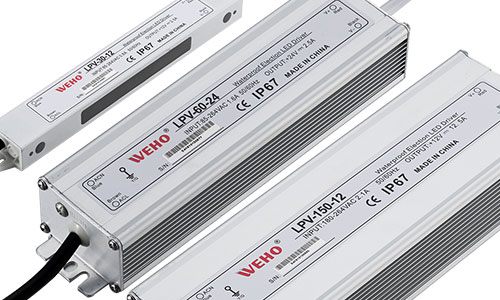LED drivers are electrical devices that supply and regulate the power to a single or string of LED lights. The way that it operates is similar to a traditional transformer, in that it transforms mains electricity into a voltage that can be used to ‘drive’ the LED lighting.
More technically, an LED driver turns the mains alternating current (universal AC input) voltage of 240V into a lower input voltage, whilst also turning it into a direct current (DC).
This allows it to regulate the power to a constant voltage of either 12V DC or 24V DC, adjusting the output voltage according to the electrical properties of the LED strips.
LED drivers are essential for your lighting setup as it stops LEDs from burning out. When LEDs turn on, their temperature increases. As this happens, the forward voltage, or the voltage required to light up the diode, decreases.
This causes the LED to draw more current in what is known as the thermal runaway, eventually pulling too much current and burning out.
However, a driver has its own power supply, and compensates for the changes in the forward voltage, regulating the power, whilst also delivering a constant current to the LED. This can help to reduce the risk of damage to your LEDs and prolong their lifespan.
CONSTANT CURRENT OR CONSTANT VOLTAGE
The first thing you need to figure out is whether you need a constant current or a constant voltage LED driver. The following are the main differences between the two:
Constant Current
◆ These drivers use a variable voltage, which allows them to deliver a constant voltageÊthroughout an electronic circuit. This allows for more control and higher efficiency. CC LED drivers can be used for single bulbs or a series of LEDs.
They are often used for office lighting, mood lighting, retail lighting, LED downlights, LED signs, and entertainment lighting. The only drawback, if the circuit is broken, then none of the LED lights will work.
Constant Voltage
◆ These drivers have a set voltage. They can be used to run several LED lights in parallel, such as LED strips or strings. However, the voltage output has to meet the voltage requirement of an entire LED string to work.
CV LED drivers are often used for outdoor lighting, street lighting, stage lighting, moving signs, architectural lighting, and LED light engines.
It’s worth noting that there are some LED drivers that contain both CV and CC options. These drivers will run as CV during standard operation but will switch to a CC mode if the output current passes its rated current limit. If you need a driver that can handle multiple applications, this type of driver could be your best option.
Advantages of using Constant Current LED Driver
When you’re building your own fixture or working with high powered LEDs, it is in your best interest to use constant-current drivers because:
▶ They avoid going way beyond the maximum current specified for the LEDs, therefore avoiding burnout/thermal runaway.
They are easier for designers to control applications, and help create light with more consistent brightness.
Advantages of using Constant Voltage LED Driver
You use a constant voltage LED driver only when using an LED or array that has been specified to take a certain voltage. This is helpful as:
▶ Constant voltage is a much more familiar technology for design and installation engineers.
▶ The cost of these systems can be lower, especially in larger-scale applications.
Considerations When Choosing an LED Driver
There are a number of things to keep in mind when selecting an LED driver:
★ First and foremost, determine the type and number of LED lights you’ll be using in your setup and how they’ll be arrayed. If your lights are wired in series, such as with ground lights or decking lights, you’ll require a constant-current LED driver.
If they’ll be wired in parallel, such as with LED tape or LED strip lights, then you’ll need to have a constant-voltage LED driver.
★ Next, you’ll need to ensure that the milliamp rating on your lights matches the milli-amp rating of your LED driver. Electrical current is measured in amps and milliamps. While there are a number of different milliamp ratings for LED lights, the most common is 350mA and 700mA.
★ Next, check to ensure that the wattage rating of your LED driver is greater than or equal to the total wattage of all lights wired to that driver. As an example, if you have five 3-watt ground lights wired to your driver, the driver must have a wattage rating of at least 15 watts.
When using LED tape, you need to multiply the wattage rating per meter of tape times the length of the tape. As an example, if the tape is rated at 15 watts per meter and the total tape length is 3 meters, your LED driver will have to carry at least a 45-watt rating.
★ Finally, make sure that the output voltage of the LED driver is compatible with the input voltage of your LED light(s). Some constant-current LED drivers to have a wide range of output voltage, such as 6 to 24 volts, making them more universal and compatible with a number of different LED lights.
Constant-current LED drivers, however, may output a very specific voltage, which may not work with your LED lights. Damage may be caused by using incorrect voltage, so it’s important to carefully check this.
Important factors when buying an LED Driver
Output Voltage
Always consider the voltage required by your light(s). If they require 12 volts for operation, use a 12-volt driver. When using a constant-current LED driver, consider the LEDs’ current output (in amps or milliamps) and ensure your driver will produce power within your lights’ specified range.
With constant-current drivers, both current range and voltage have to be considered. With constant-voltage drivers, only the voltage range needs to be considered.
Input Voltage
While most LED drivers will accept a range of input voltages, ensure that the voltage available at your location is compatible with the driver you’re using. Most household voltage is 120 volts, while most commercial and industrial voltages are 277 volts.
If you’re unsure, check with your electrician. When dealing with constant-current LEDs, consider their current input as well.
Wattage
Calculate the total wattage of your light or lights and ensure your driver has a maximum wattage capability greater than this. Don’t use a driver with a light or lights that exceed its max wattage or that uses less than 50% of its max wattage.
Dimming
Constant-current and constant-voltage LED drivers can both be made with the ability to dim, but the dimming capability must be stated on the dimmer’s specs, otherwise, it’s safe to assume the system is not dimmable.
Thank you for reading along and hopefully, this post has provided you with the information needed in understanding and choose the right LED Driver for your application. Meanwhile, you may want to learn more and browse through our site www.wehopower.com.









